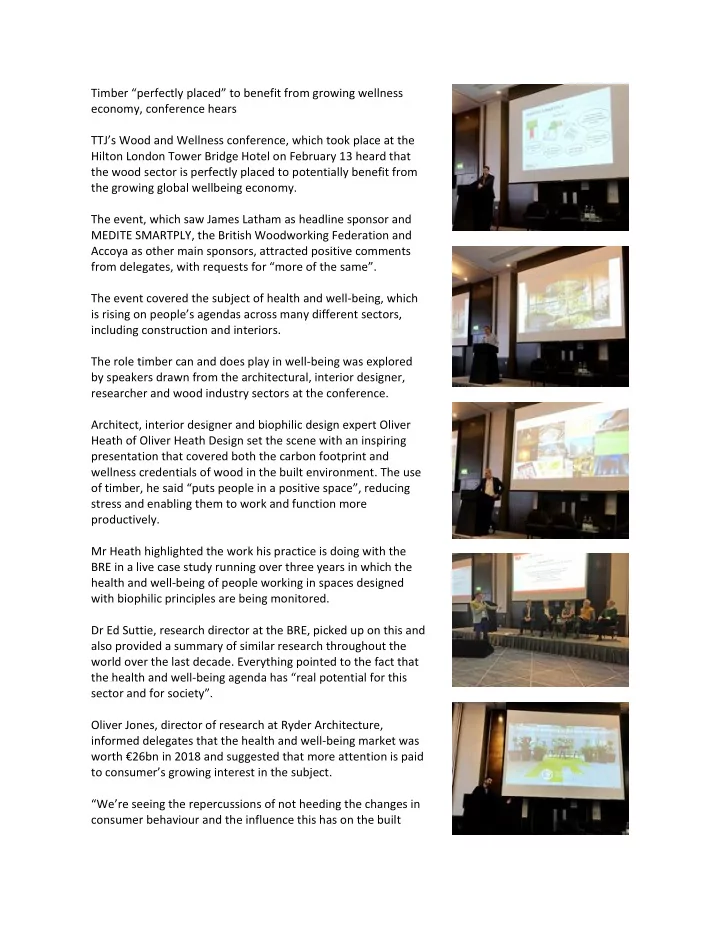

Timber “perfectly placed” to benefit from growing wellness economy, conference hears TTJ’s Wood and Wellness conference, which took place at the Hilton London Tower Bridge Hotel on February 13 heard that the wood sector is perfectly placed to potentially benefit from the growing global wellbeing economy. The event, which saw James Latham as headline sponsor and MEDITE SMARTPLY, the British Woodworking Federation and Accoya as other main sponsors, attracted positive comments from delegates, wit h requests for “more of the same”. The event covered the subject of health and well-being, which is rising on people’s agendas across many different sectors, including construction and interiors. The role timber can and does play in well-being was explored by speakers drawn from the architectural, interior designer, researcher and wood industry sectors at the conference. Architect, interior designer and biophilic design expert Oliver Heath of Oliver Heath Design set the scene with an inspiring presentation that covered both the carbon footprint and wellness credentials of wood in the built environment. The use of timber, he said “puts people in a positive space”, reducing stress and enabling them to work and function more productively. Mr Heath highlighted the work his practice is doing with the BRE in a live case study running over three years in which the health and well-being of people working in spaces designed with biophilic principles are being monitored. Dr Ed Suttie, research director at the BRE, picked up on this and also provided a summary of similar research throughout the world over the last decade. Everything pointed to the fact that the health and well- being agenda has “real potential for this sector and for society”. Oliver Jones, director of research at Ryder Architecture, informed delegates that the health and well-being market was worth €26bn in 2018 and suggested that more attention is paid to consumer’s growing interest in the subject. “We’re seeing the repercussions of not heeding the changes in consumer behaviour and the influence this has on the built
environment,” he said, in a reference to the changing face of the high street. Furniture maker Sean Sutcliffe, co-founder of Benchmark, spoke about his company’s increasing focus on well-being. It has always been driven by sustainability principles but was now taking it further with furniture designs geared towards providing “tangible evidence of nature in our workplaces”. A new range with this specific goal in mind will be launched in London in September. DaeWha Kang, lead designer at DaeWha Kang Design and Alex Morris, a psychologist and head of workplace well-being and behavioural change at facilities management company Mitie provided a fascinating insight into the Winter Gardens project at the Shard. Here, several areas of Mitie’s office space has been fitted out with wood products as part of a “Living Lab” experiment to assess worker performance and well-being. Results showed that staff rated themselves as up to 20% more productive. Alex de Rijke, director at dRMM Architects, highlighted timber’s potential in the healthcare sector with his profile of Maggie’s Oldham, which saw the first use in the UK of hardwood (tulipwood) CLT. The education sector was under the spotlight with Eleanor Brough, an associate at Sarah Wigglesworth Architects, who outlined the award-winning “Tree - Top Classroom” extension at Mellor Primary School in the Peak District. The extension was designed to support the enhancement of the school’s curriculum and in doing so “connected with the landscape”. Covered timber decking areas enable the children to spend as much time outside as possible and the structure features larch glulam portal frames, while the interior is fitted out with birch plywood joinery. There is a real sense of your [woodland] surroundings in the classroom, said Ms Brough, and the importance of keeping in touch with the forests was amplified by Chris Sutton, managing director of conference headline sponsor James Latham, who explained his company’s long association with the National Forest. David Bourque, director of development at the National Forest, described the progress made since the forest establishment
began in 1995 and how the lan dscape and people’s lives had been transformed. James Latham provided each delegate with a complimentary copy of “Shinrin - Yoku, the art and science of forest bathing”, a book that describes the benefits of spending time in the forests and a principle tha t is now part of Japan’s public health programme. Other features of the day included an “idea showcase”, in which Colin Wheatley, product manager at MEDITE SMARTPLY and John Alexander, director of sales and product development at Accsys Group, highlighted how their products dovetailed with the health and well-being agenda, and panel discussions. A full report will appear in the next issue of TTJ.
Recommend
More recommend